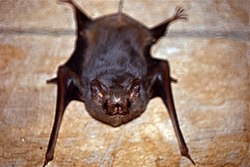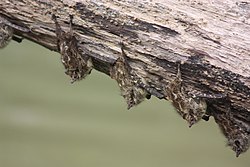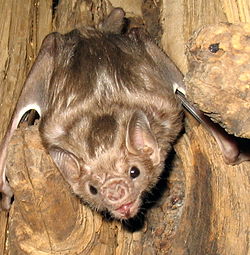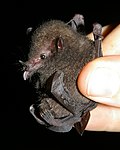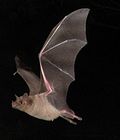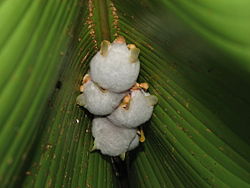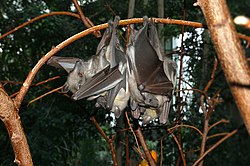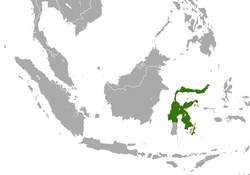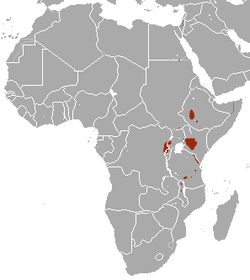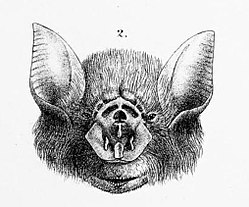| Name | Authority and species | Range | Size and ecology |
|---|
| Antrozous  | H. Allen, 1862
| Western North America and Cuba
 | Size: 5–9 cm (2–4 in) long, plus 3–6 cm (1–2 in) tail [139]
Habitats: Forest, rocky areas, and caves [148] |
|---|
Arielulus
(gilded sprite)  | Hill & Harrison, 1987
| Southeastern Asia | Size range: 4 cm (2 in) long, plus 3 cm (1 in) tail (bronze sprite) to 7 cm (3 in) long, plus 5 cm (2 in) tail (necklace sprite) [139]
Habitats: Forest and inland wetlands [149] |
|---|
Baeodon
(yellow bat) | Miller, 1906
| Southern Mexico | Size range: 4–5 cm (2–2 in) long, plus 3–5 cm (1–2 in) tail (multiple) [139]
Habitat: Forest [150] |
|---|
Barbastella
(barbastelle)  | Gray, 1821
| Europe, northern Africa, and western, southern, and eastern Asia | Size range: 4 cm (2 in) long, plus 4 cm (2 in) tail (eastern barbastelle) to 6 cm (2 in) long, plus 5 cm (2 in) tail (Beijing barbastelle) [139]
Habitats: Shrubland, forest, caves, and rocky areas [151] |
|---|
| Bauerus 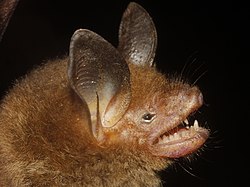 | Van Gelder, 1959
| Southern Mexico and Central America
 | Size: 5–8 cm (2–3 in) long, plus 4–6 cm (2–2 in) tail [139]
Habitat: Forest [152] |
|---|
Chalinolobus
(wattled bat)  | Peters, 1866
| New Zealand, Australia, and New Caledonia | Size range: 4 cm (2 in) long, plus 3 cm (1 in) tail (chocolate wattled bat) to 8 cm (3 in) long, plus 5 cm (2 in) tail (Gould's wattled bat) [139]
Habitats: Savanna, shrubland, forest, caves, and grassland [153] |
|---|
Corynorhinus
(American lump-nosed bat)  | H. Allen, 1865
| North America | Size range: 3 cm (1 in) long, plus 4 cm (2 in) tail (Rafinesque's big-eared bat) to 6 cm (2 in) long, plus 6 cm (2 in) tail (Mexican big-eared bat) [139]
Habitats: Shrubland, forest, and caves [154] |
|---|
Eptesicus
(serotine bat)  | Rafinesque, 1820
| North America, South America, Africa, Europe, and Asia | Size range: 4 cm (2 in) long, plus 3 cm (1 in) tail (Argentine brown bat) to 9 cm (4 in) long, plus 6 cm (2 in) tail (big brown bat) [139]
Habitats: Savanna, shrubland, forest, caves, desert, rocky areas, grassland, and inland wetlands [155] |
|---|
| Euderma  | H. Allen, 1892
| Western North America
 | Size: 6–7 cm (2–3 in) long, plus 4–5 cm (2–2 in) tail [139]
Habitats: Forest, caves, and desert [156] |
|---|
Falsistrellus
(false pipistrelle) | Troughton, 1943
| Australia | Size range: 5–7 cm (2–3 in) long, plus 4–6 cm (2–2 in) tail (multiple) [139]
Habitat: Forest [157] |
|---|
Glauconycteris
(butterfly bat)  | Dobson, 1875
| Sub-Saharan Africa | Size range: 3 cm (1 in) long, plus 3 cm (1 in) tail (Allen's spotted bat) to 7 cm (3 in) long, plus 5 cm (2 in) tail (pied butterfly bat) [139]
Habitats: Shrubland, savanna, and forest [158] |
|---|
Glischropus
(thick-thumbed bat)  | Dobson, 1875
| Southeastern Asia | Size range: 4 cm (2 in) long, plus 3 cm (1 in) tail (common thick-thumbed bat) to 5 cm (2 in) long, plus 5 cm (2 in) tail (Indochinese thick-thumbed bat) [139]
Habitat: Forest [159] |
|---|
Hesperoptenus
(false serotine)  | Peters, 1868
| Southern and southeastern Asia | Size range: 3 cm (1 in) long, plus 3 cm (1 in) tail (Blanford's bat) to 8 cm (3 in) long, plus 7 cm (3 in) tail (Tickell's bat) [139]
Habitats: Forest and caves [160] |
|---|
Histiotus
(big-eared brown bat) 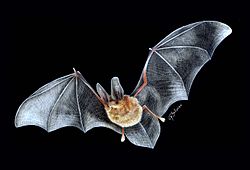 | Gervais, 1856
| South America | Size range: 5 cm (2 in) long, plus 4 cm (2 in) tail (big-eared brown bat) to 8 cm (3 in) long, plus 6 cm (2 in) tail (tropical big-eared brown bat) [139]
Habitats: Forest and caves (some species unknown) [161] |
|---|
Hypsugo
(Asian pipistrelle)  | Kolenati, 1856
| Europe, northern Africa, and Asia | Size range: 3 cm (1 in) long, plus 3 cm (1 in) tail (Alashanian pipistrelle) to 6 cm (2 in) long, plus 5 cm (2 in) tail (Anthony's pipistrelle) [139]
Habitats: Savanna, shrubland, forest, caves, desert, grassland, rocky areas, and inland wetlands [162] |
|---|
| Ia | Thomas, 1902
| Eastern Asia
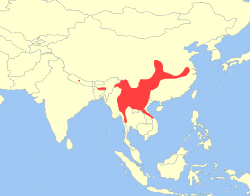 | Size: 8–11 cm (3–4 in) long, plus 4–9 cm (2–4 in) tail [139]
Habitats: Forest and caves [163] |
|---|
| Idionycteris 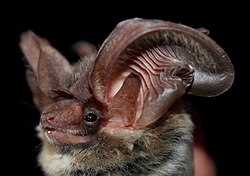 | Anthony, 1923
| Western United States and Mexico
 | Size: About 7 cm (3 in), plus 4–6 cm (2 in) tail [139]
Habitats: Forest, caves, and desert [164] |
|---|
Laephotis
(African long-eared bat) | Thomas, 1901
| Africa | Size range: 4 cm (2 in) long, plus 3 cm (1 in) tail (Angolan long-eared bat) to 7 cm (3 in) long, plus 5 cm (2 in) tail (De Winton's long-eared bat) [139]
Habitats: Savanna, shrubland, desert, grassland, and inland wetlands [165] |
|---|
| Lasionycteris  | Peters, 1866
| North America
 | Size: 5–7 cm (2–3 in) long, plus 3–5 cm (1–2 in) tail [139]
Habitats: Forest, rocky areas, and caves [166] |
|---|
Lasiurus
(red bat)  | Gray, 1831
| North and South America | Size range: 4 cm (2 in) long, plus 3 cm (1 in) tail (minor red bat) to 9 cm (4 in) long, plus 9 cm (4 in) tail (Cuban yellow bat) [139]
Habitats: Savanna, shrubland, forest, and caves [167] |
|---|
| Mimetillus  | Thomas, 1904
| Sub-Saharan Africa | Size: 5–7 cm (2–3 in) long, plus 2–4 cm (1–2 in) tail [139]
Habitats: Forest and savanna [168] |
|---|
Neoromicia
(serotine)  | Roberts, 1926
| Sub-Saharan Africa | Size range: 3 cm (1 in) long, plus 2 cm (1 in) tail (Heller's serotine) to 8 cm (3 in) long, plus 4 cm (2 in) tail (cape serotine) [139]
Habitats: Savanna, shrubland, forest, desert, grassland, and inland wetlands [169] |
|---|
Nyctalus
(noctule bat)  | Bowdich, 1825
| Europe, northern Africa, and Asia | Size range: 4 cm (2 in) long, plus 3 cm (1 in) tail (Lesser noctule) to 11 cm (4 in) long, plus 7 cm (3 in) tail (Birdlike noctule) [139]
Habitats: Shrubland, forest, caves, rocky areas, and inland wetlands [170] |
|---|
| Nycticeinops 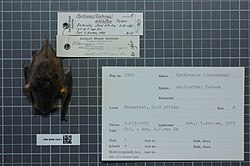 | Hill & Harrison, 1987
| Africa | Size: 3–5 cm (1–2 in) long, plus 2–4 cm (1–2 in) tail [139]
Habitats: Savanna, shrubland, and desert [171] |
|---|
Nycticeius
(evening bat) 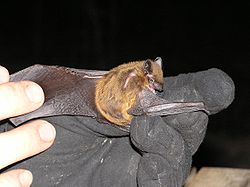 | Rafinesque, 1819
| Western Cuba, South America, and southern North America | Size range: 4 cm (2 in) long, plus 2 cm (1 in) tail (Temminck's mysterious bat) to 6 cm (2 in) long, plus 5 cm (2 in) tail (evening bat) [139]
Habitat: Forest [172] |
|---|
Nyctophilus
(Australian big-eared bat)  | Leach, 1821
Seventeen species (one extinct) | Australia and southeastern Asia | Size range: 3 cm (1 in) long, plus 3 cm (1 in) tail (eastern long-eared bat) to 8 cm (3 in) long, plus 6 cm (2 in) tail (greater long-eared bat) [139]
Habitats: Savanna, shrubland, forest, caves, grassland, and inland wetlands [173] |
|---|
Otonycteris
(long-eared bat) 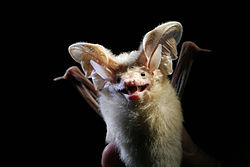 | Peters, 1859
| Western Asia and northern Africa | Size range: 5–9 cm (2–4 in) long, plus 4–7 cm (2–3 in) tail (desert long-eared bat) [139]
Habitats: Grassland, shrubland, rocky areas, and desert [174] |
|---|
| Parastrellus  | Hoofer, Van Den Bussche, & Horáček, 2006
| Western United States and Mexico (in red)
 | Size: 3–6 cm (1–2 in) long, plus 2–4 cm (1–2 in) tail [139]
Habitats: Forest, grassland, rocky areas, caves, and desert [175] |
|---|
| Perimyotis  | Menu, 1984
| Eastern North America (in yellow)
 | Size: 4–5 cm (2–2 in) long, plus 3–5 cm (1–2 in) tail [139]
Habitats: Forest, rocky areas, and caves [176] |
|---|
| Pharotis | Thomas, 1914
| Papua New Guinea
 | Size: 4–5 cm (2–2 in) long, plus 4–5 cm (2–2 in) tail [139]
Habitat: Forest [177] |
|---|
| Philetor  | Thomas, 1902
| Southeastern Asia
 | Size: 5–7 cm (2–3 in) long, plus 3–4 cm (1–2 in) tail [139]
Habitats: Forest and grassland [178] |
|---|
Pipistrellus
(pipistrelle) 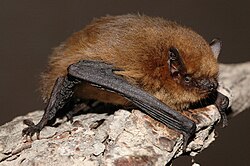 | Kaup, 1829
| Australia, Africa, Europe, Japan, and western, southern, and southeastern Asia | Size range: 3 cm (1 in) long, plus 2 cm (1 in) tail (Angulate pipistrelle) to 7 cm (3 in) long, plus 5 cm (2 in) tail (Kelaart's pipistrelle) [139]
Habitats: Savanna, shrubland, forest, caves, desert, rocky areas, grassland, intertidal marine, and inland wetlands [179] |
|---|
Plecotus
(lump-nosed bat)  | Geoffroy, 1818
| Europe, Asia, and northern Africa | Size range: 3 cm (1 in) long, plus 3 cm (1 in) tail (brown long-eared bat) to 6 cm (2 in) long, plus 6 cm (2 in) tail (alpine long-eared bat) [139]
Habitats: Savanna, shrubland, forest, caves, desert, grassland, and rocky areas [180] |
|---|
Rhogeessa
(yellow bat)  | H. Allen, 1866
| Mexico, Central America, and South America | Size range: 3 cm (1 in) long, plus 2 cm (1 in) tail (black-winged little yellow bat) to 5 cm (2 in) long, plus 4 cm (2 in) tail (Bickham's little yellow bat) [139]
Habitats: Shrubland and forest [181] |
|---|
| Rhyneptesicus | Bianchi, 1917
| Western Asia | Size: 4–6 cm (2–2 in) long, plus 3–5 cm (1–2 in) tail [139]
Habitats: Forest, savanna, caves, and desert [182] |
|---|
| Scoteanax  | Troughton, 1944
| Eastern Mexico
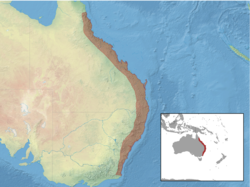 | Size: 6–8 cm (2–3 in) long, plus 4–6 cm (2–2 in) tail [139]
Habitat: Forest [183] |
|---|
Scotoecus
(lesser house bat) | Thomas, 1901
| Sub-Saharan Africa and southern Asia | Size range: 4–6 cm (2–2 in) long, plus 2–5 cm (1–2 in) tail (multiple) [139]
Habitats: Shrubland, savanna, and forest [184] |
|---|
| Scotomanes  | Dobson, 1875
| Eastern and southeastern Asia
 | Size: 6–9 cm (2–4 in) long, plus 5–7 cm (2–3 in) tail [139]
Habitats: Forest and caves [185] |
|---|
Scotophilus
(Old World yellow bat)  | Leach, 1821
| Southern and southeastern Asia and Sub-Saharan Africa | Size range: 5 cm (2 in) long, plus 3 cm (1 in) tail (lesser Asiatic yellow bat) to 13 cm (5 in) long, plus 10 cm (4 in) tail (Schreber's yellow bat) [139]
Habitats: Savanna, shrubland, forest, desert, and grassland (some species unknown) [186] |
|---|
Scotorepens
(broad-nosed bat)  | Troughton, 1943
| Australia, Timor-Leste, and Papua New Guinea | Size range: 3 cm (1 in) long, plus 2 cm (1 in) tail (little broad-nosed bat) to 6 cm (2 in) long, plus 4 cm (2 in) tail (eastern broad-nosed bat) [139]
Habitats: Savanna, shrubland, forest, desert, and grassland [187] |
|---|
| Scotozous | Dobson, 1875
| Southern Asia | Size: 3–6 cm (1–2 in) long, plus 2–5 cm (1–2 in) tail [139]
Habitats: Forest, shrubland, and desert [188] |
|---|
| Thainycteris | Kock & Storch, 1996
| Laos and Thailand | Size: 6–7 cm (2–3 in) long, plus 4–6 cm (2–2 in) tail [139]
Habitat: Forest [189] |
|---|
Tylonycteris
(bamboo bat)  | Peters, 1872
| Southeastern Asia | Size range: 2 cm (1 in) long, plus 2 cm (1 in) tail (pygmy bamboo bat) to 5 cm (2 in) long, plus 4 cm (2 in) tail (greater bamboo bat) [139]
Habitat: Forest [190] |
|---|
Vespadelus
(forest bat)  | Troughton, 1943
| Australia | Size range: 3 cm (1 in) long, plus 3 cm (1 in) tail (eastern cave bat) to 6 cm (2 in) long, plus 4 cm (2 in) tail (large forest bat) [139]
Habitats: Savanna, shrubland, forest, caves, desert, and grassland [191] |
|---|
Vespertilio
(parti-coloured bat)  | Linnaeus, 1758
| Europe and Asia | Size range: 4 cm (2 in) long, plus 3 cm (1 in) tail (parti-coloured bat) to 8 cm (3 in) long, plus 6 cm (2 in) tail (Asian particolored bat) [139]
Habitats: Shrubland, coastal marine, forest, caves, desert, rocky areas, grassland, and inland wetlands [192] |
|---|


